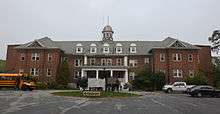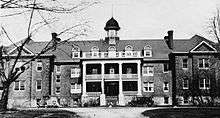Mohawk Institute Residential School
The Mohawk Institute Residential School was a Canadian Indian residential school in Brantford, Ontario, Canada. The School operated under the Government of Canada from July 1, 1885 to June 27, 1970. Prior to 1885 the Anglican Church of Canada was involved in the operation of a school and residential school in the same location. Enrollment at the school ranged from 90 to 200 students per year.

History

It was operated by the Anglican Church of Canada from its founding as the "Mechanics' Institute" (a day school for boys on the Six Nations of the Grand River reserve) in 1828 until 1969, when control was handed over to the Canadian federal government.[1] The Mohawk Institute was established on 350-acres of farm land, all of which were or had been part of the land of Six Nations at some point.[2]
In 1831, the school began to function as a residential school for boys, and starting in 1834, girls were taken in as boarders as well.[1] Children from Six Nations were sent there, along with some from the New Credit, and Moraviantown, Sarnia, Walpole Island, Muncey, Scugog, Stoney Point, Saugeen, Bay of Quinte and Kahnawake reserves.
While the school was originally nearby the Mohawk village, in 1837 the colonial government of Upper Canada ordered Six Nation residents to resettle south of the Grand River, kilometres from the school.[1] Between 1854–1859, the building was destroyed by fire and rebuilt a few hundred metres from its original location.[1] Around the same time, the school acquired more land, and farming became a prominent part of life for children at the school. In 1885, the year after the Indian Act made enrollment compulsory for Status Indian children under 16,[3] the school began to accept students from reserves beyond Six Nations.[1]
On April 19, 1903, the main school building was again destroyed by fire. In May, the barns of the Mohawk School were also destroyed by fire. On June 24, 1903 the playhouse which had been serving as the boys' dorm since the main fire in April was also burned down. All three of these fires have been attributed to students at the school.[4] The school buildings were rebuilt the following year. The new school building contained separate boys and girls wings, principal's and teachers quarters, as well as administrative offices.[1] This new school building was designed to hold 150 students and also included the development of barns, stables, and other agriculture related out buildings.[2]
In 1922, the management of the school was formally taken over by the Canadian government, though the Anglican church retained ownership, and the agreement required that the principal be Anglican.[1] A chapel was added to the school in 1930.[2] By 1955, enrollment reached 185 children.[1]
In 1963, farming was discontinued as the children were now given a full day of education without requiring their manual labour.[1] Enrollment decreased as schools were built in reserve throughout Ontario, and in 1970, the school was closed. Six Nations assumed ownership of the building the following year.
Abuse
Many former students have described suffering physical, sexual and emotional abuse at the school.[5][6][7] The poor quality of food served to students led to the school's nickname, The Mush Hole.
In 1914 two former students from the Mohawk School charged the school's principal for cutting off their hair, imprisonment, and physical abuse. The case went to trial on March 31, 1914 where the students were awarded $400 for two of the claims and the Principal was fined.[4]
Students escaping the premises of Mohawk Institute proved to be an issue, so the staff built a prison cell to hold students who tried to leave in the basement. It resembled a dark closet, and students were often left in there for days at a time. One former student, Lorna, who attended the Mohawk Institute from 1940 to 1945, recalled being given shock treatment for wetting the bed. "They used to bring in a battery—a motor of some sort or some kind of gadget, and he’d put the girl’s hand on it and it would jerk us and it would go all the way through us from end to end—it would travel. And we would do that about three times."[8] Another former student, Dawn, recalls the sexual abuse that would occur in the boiler room in the basement.[9] "You couldn’t hear their screams over the noise of the boiler."
Sally General, a former student who attending Mohawk Institute from ages four to thirteen, recalls having all of her hair cut off with all of the other students. They were branded "Mush Hole Baldies". Sally also remembers being locked in a dark room with her friend and being told by staff that "the rats were gonna get us".[9] They would cry for hours not knowing why they were being punished. It wasn't until she learned English that she realized she was being punished for not knowing or speaking English. Sally was also the victim of sexual abuse. After one of the times she was assaulted, she began to bleed and went to the nurse. When she told the nurse what happened, the nurse gave her a beating, told her she was lying, and that she should never say anything like that again.
Male children at the Mohawk Institute were forced to get a circumcision and their tonsils removed.[9]
Principals
The following individuals served as principals of the Mohawk Institute during its operation:[1]
| Principal Name | Years |
|---|---|
| Rev. Robert Ashton (Also Chaplain of Mohawk Chapel from 1885-1915) | 1870-1903 |
| A. Nelles Ashton | 1903-1914 |
| Alice M. Boyce (Acting Principal) | 1914-1915 |
| Rev. Cyril M. Turnell | 1915-1918 |
| Alice. M. Boyce | 1918-1922 |
| Sydney Rogers | 1922-1929 |
| Rev. Horace W. Snell (Also Chaplain of Mohawk Chapel) | 1929-1945 |
| Rev. William John Zimmerman (Principal/Administrator and Chaplain of Mohawk Chapel) | 1945-1950 |
Present Day
Following the closure of the Mohawk Institute in 1970 the Woodland Cultural Centre opened on the site in 1972, as an organization focused on research, history, and later the arts.[10] Woodland's cultural and historical interpretation programming utilizes the historic Mohawk Institute building to teach about the history of residential schools in Canada.[11]
In 2013 a leak in the roof of the residential school building caused significant damage to the historic site. As a result of this leak a community input process was established within Six Nations of the Grand River to determine what the local community wanted to do with the building, 98% of participants voted to save the historic building.[12] In March 2014 the "Save the Evidence" campaign was started to raise money to preserve the Mohawk Institute and to raise awareness about the history of residential schools.[10]
Artistic Works
The history and student experience at the Mohawk Institute has contributed to the works of a number of authors and artists including:
- Graham, Elizabeth (1997). The Mush Hole: Life at Two Indian Residential Schools. Waterloo, Ontario: Heffle Publishing. ISBN 0-9683179-0-1.
- Harper, Maddie (1993). "Mush-hole" Memories of a Residential School. Carlos Freire. Toronto, Ontario: The Turtle Island Publication Group. ISBN 0-920813-98-4.
- "Mush Hole Remembered: R.G. Miller", a series of paintings by artist R.G. Miller based on his experience as a student at the Mohawk Institute.[13]
- "Opening Doors to Dialogue" community art project led by Samuel Thomas and the Woodland Cultural Centre used the physical building of the Mohawk Institute as inspiration for a community dialogue, healing, and art.[14]
References
- http://www.anglican.ca/relationships/trc/histories/mohawk-institute
- Auger, Donald J. (2005). Indian Residential Schools in Ontario. Nishnawbe Aski Nation. pp. 171–180.
- Residential Schools, Canadian Encyclopedia
- "Mohawk Institute Indian Residential School IAP Narrative" (PDF). National Centre for Truth and Reconciliation. May 31, 2013. Retrieved May 5, 2017.
- 'We're never going to heal', December 15, 2008
- Tales of the Mush Hole retold
- "Douglas George-Kanetiio" in Native Americans Today: A Biographical Dictionary, Bruce Elliott Johansen (ed)
- Eshet, Dan (2015). Stolen Lives: The Indigenous Peoples of Canada and the Indian Residential Schools. Facing History and Ourselves. pp. 143–146.
- Douglas, Ron (Director) (2009). Unseen Tears: The Native American Boarding School Experience in Western New York. Native American Community Services of Erie and Niagara Counties. OCLC 613983241.
- Koblun, Jason (2017-03-01). "Update on Mohawk Institute renovations". Two Row Times. Retrieved 2017-05-12.
- Brown, Louise (July 2, 2016). "Giving a voice to residential school ghosts | Toronto Star". thestar.com. Retrieved 2017-05-12.
- Peeling, Mike (2016-12-28). "Brant News' Community Hero Award: Save the Evidence campaign | BrantNews.com". BrantNews.com. Retrieved 2017-05-12.
- "Exhibit explores abuse of Six Nations youths". Rochester Democrat and Chronicle. October 23, 2013. Retrieved 2017-05-12.
- Toms, Colleen (2016-09-06). "Opening the Doors to Dialogue exhibit at Woodland Cultural Centre | BrantNews.com". BrantNews.com. Retrieved 2017-05-12.